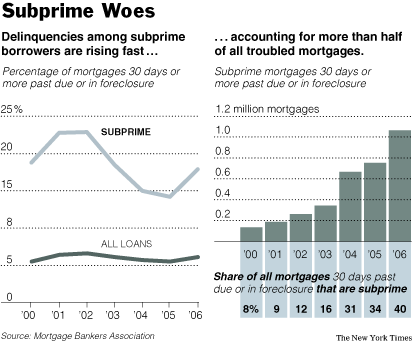| Want to send this page or a link to a friend? Click on mail at the top of this window. |
More Special Reports |
| Posted March 22, 2007 |
| For Some Subprime Borrowers, Few Good Choices |
 |
|
Erik Jacobs for The New York Times |
|
| Lillie Searcy, head of a family center in the Mattapan section of Boston, tries to help homeowners in trouble. |
By VIKAS BAJAJ |
Myriam Philemond says she knew almost from the start that she and her husband could not afford the nearly $500,000 house they bought in South Boston more than a year ago.
After falling behind on payments in July, she is considering whether to turn the house over to her mortgage company because she cannot refinance and modifying her loan will not help. “We are stuck with a house that we can’t afford,” she said.
As problems with subprime mortgages have escalated, officials on Wall Street as well as in Washington have urged lenders and the government to step in and cushion the blow to troubled borrowers and find ways to enable them to remain in their homes.
That may not be possible in many cases.
Like Ms. Philemond, some will not be in a position to keep their homes because the properties they live in — bought during the boom in housing prices — are no longer worth what they paid. Some properties may be worth still less because the price was previously overstated. Many borrowers’ incomes, which were often not verified, are insufficient to cover house payments, taxes, home insurance and other requirements.
“There is no way they can keep their homes,” Lillie Searcy, executive director of the Mattapan Family Service Center, said about borrowers like Ms. Philemond, whom she has been helping. “It’s impossible.”
And in an unusual twist, the process of packaging and reselling home loans to investors — known as securitization, which has provided much of the cash that fueled subprime lending — has also made it harder to modify debts that go bad.
At the end of last year, more than 2.6 million home loans were either past due for more than 30 days or in foreclosure. About 40 percent of them were made to people with weak, or subprime, credit. Most economists predict that the number of troubled loans will continue to rise this year as more mortgages are adjusted to higher interest rates and home prices decline further.
Last year, more than 37 percent of subprime loans were made without verification of borrowers’ incomes, up from 15 percent in 2000, according to an analysis by JPMorgan Chase. Also, a third of borrowers took out a second mortgage, up from 6.8 percent in 2003, suggesting that they did not have enough money for a down payment.
For these borrowers, the best alternatives, according to some housing specialists, may include short sales, in which a lender accepts a sale for less than what is owed on the house, or a deed in lieu of foreclosure, where a lender takes ownership of a house instead of full payment of the mortgage.
Rising default rates have thus far had a modest impact on the overall economy, but economists fear that the problems could intensify if a broader range of borrowers, including those with stronger credit, start falling behind on payments. A big increase in the number of homes for sale, because of rising foreclosures, would put more pressure on prices and limit home buying and consumer spending.
The Senate Banking Committee will hold a hearing on problems in the subprime market today in Washington. Senator Christopher J. Dodd, Democrat of Connecticut and the committee’s chairman, has suggested that the federal government may need to bail out homeowners in trouble, and some housing advocacy groups are calling for a moratorium on foreclosures.
Ms. Philemond, a receptionist, and her husband, who owns a sign business, have made several payments to try to catch up on past-due payments, but they are still thousands of dollars behind. She is unsure that they will be able to pay off the money overdue, let alone make the regular $3,800 monthly payments on two mortgages. The interest rate on her primary mortgage, now 6.99 percent, will become adjustable early in 2008, making the payments even higher.
Ms. Searcy said it appeared that the couple’s income had been overstated on the mortgage application by brokers who had helped them buy the house and get a loan from WMC Mortgage, a unit of General Electric.
____________ |
|
| Income was often unverified or a house's value overstated. | |
____________ |
WMC said that it had granted Ms. Philemond the loan because the information on her application indicated that she and her husband had income of more than $100,000 a year, savings exceeding $60,000 and had a tenant. This month, the company restricted the use of loans in which borrowers state their income without verification.
A spokesman for General Electric’s finance division, Robert J. Rendine, said, “The industry is becoming aware that because of the stresses that we are seeing, issues like this are being exposed.”
Loss mitigation efforts by mortgage lenders and government subsides, to be clear, can help borrowers and limit losses. But experience thus far suggests that a more concerted and coordinated effort will be needed. It may also require a change in the policies governing what can be done with securitized loans. Skip to next paragraph Multimedia Graphic Subprime Woes
To increase a borrower’s chance of making required payments, lenders can do things like lowering interest rates on the loans, waiving past-due payments and fees, and extending the periods in which low teaser rates apply to loans.
But the options vary greatly, based on who owns the mortgages. Generally speaking, loans held by the banks that made them in the first place can be modified most easily. Loans that have been securitized are typically subject to greater restrictions, according to the terms on which they were sold to investors. Payments made by borrowers whose loans have been securitized are collected and processed by mortgage servicers.
According to a Bear Stearns analysis, half of all mortgage securities that make up a widely followed index allow the servicer to modify the interest rate, principal balance or maturity of a loan; 40 percent allow some modifications but require approval from a ratings agency if more than 5 percent of a pool of mortgages is changed, and 10 percent of loan pools allow no changes. About half of all modifications are successful at preventing foreclosures, according to the investment bank.
 |
The restrictions are intended to protect investors against tampering with the cash flow generated by the loans. But in times of greater distress, investors prefer modifications that let them continue earning a return rather than having the property foreclosed, a costly process.
“You will see a greater willingness to work with borrowers,” said Gyan Sinha, a senior analyst who follows the subprime market for Bear Stearns.
Much of the revamping will start occurring once investors sell off or write down the value of the loans to account for decreases in home prices and the delinquent status of the loans, said Stan Ross, chairman of the Lusk Center for Real Estate at the University of Southern California. Some borrowers may find that they can stay in their homes if the value is written down enough.
“You mark the asset down to current value,” Mr. Ross said, “then you look at the borrower and say, ‘Is this the borrower that will repay me?’ ”
But housing counselors and lawyers who have worked on behalf of borrowers say their experience suggests that is not yet happening.
They say that many servicers are unwilling to discuss modifications until loans are at least three months past due, a point when many borrowers are in deep financial trouble. Also, servicers are often unwilling or unable to make big enough changes to account for inflated appraisals and income levels that were used in underwriting the loans.
“Some of them take hundreds and hundreds of hours” of work and negotiations, said Diane Thompson, a lawyer at the Land of Lincoln Legal Assistance Foundation in East St. Louis, Ill. “It seems to me that is a terrible waste of our resources. It would be much better if the bad loans were never made, and if they were made, we would get people to accept responsibility for them.”
Officials at some big mortgage servicers declined to discuss their practices, but an executive at Wells Fargo, which services the seventh-largest subprime loan portfolio, according to Inside Mortgage Finance, a trade publication, says it has taken an active approach.
Mary Coffin, executive vice president for servicing at Wells Fargo Home Mortgage, said the company repeatedly warns borrowers about coming interest rate changes, gives them access to loss-mitigation specialists before they are delinquent for 90 days, and refers them to financial counselors if they need such help.
“The sooner that we work with them, the more success we will have,” Ms. Coffin said. She also asserted that the company did not make loans that allowed customers to put little or no money down, which she acknowledged were a lot harder to modify or refinance because the owners typically had no equity in their properties.
Consider Andrew D. Sobel, a 48-year-old in San Diego, who took out two mortgages to buy a $240,000 condominium in 2004 and is now facing its sale for $175,000. He could not afford higher monthly payments that took effect in September, when his loan was converted to a variable interest rate. Countrywide, which services his loan, would not agree to modify the loan but was willing to accept the short sale. He could not refinance because the home is worth less than what he owes on the property.
“There was never any effort to try to keep me in my home,” he said.
More borrowers may find themselves in a similar situation in the next two years as the first interest rate adjustments take effect on loans in 2004 and 2005. Those who continue to have spotty credit and little equity in their homes will be at the greatest risk because many lenders are no longer offering no-money-down mortgages to people with weak credit.
“If someone calls and says they want do a 100 percent loan,” said Jeff Jaye, a mortgage broker in San Jose, Calif., “my antenna goes up. My first question is ‘What’s your credit score?’ ”
Copyright 2007 The New York Times Company. Reprinted from The New York Times, Business Day, of Thursday, March 22, 2007.
| Wehaitians.com, the scholarly journal of democracy and human rights |
| More from wehaitians.com |